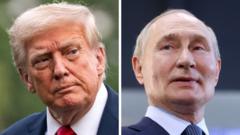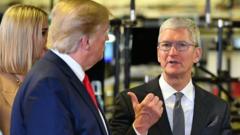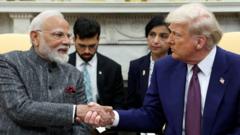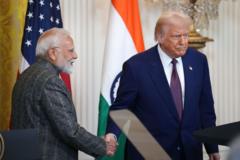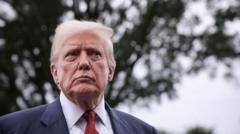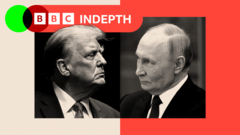The latest trade measures aim to reshape US foreign economic relations and military strategies.
**Trump Implements Significant Tariffs Impacting Global Trade**
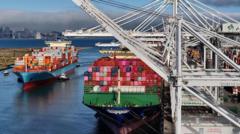
**Trump Implements Significant Tariffs Impacting Global Trade**
US President's new tariffs affect over 90 countries, targeting import rates and trade practices.
On Thursday, US President Donald Trump put into effect a sweeping new set of tariffs targeting more than 90 countries globally, igniting a new phase in his trade agenda. As the deadline for negotiations approached, Trump shared via his Truth Social account that substantial financial inflows were already being generated for the United States due to these tariffs.
The administration's overarching goal with these tariffs is to enhance American manufacturing and job growth while seeking to rectify what Trump perceives as an imbalanced global trading landscape. On the same day, Trump issued a warning to India, threatening to hike tariffs on imports from the nation to 50% unless it ceased purchasing oil from Russia. Furthermore, discussions are underway for a potential 100% tariff on foreign-made semiconductors to incentivize tech investments within the US.
The newly established tariffs draw from a commitment Trump made upon returning to office in January, which asserts a strategy to diminish the trade deficit — the difference between US imports and exports. Tariffs function by imposing a tax on US importers purchasing goods from other countries, with potential downstream effects on consumers as businesses may choose to pass these costs onto them.
The current average tariff rate within the US has reached a peak not seen in nearly a century, influenced by industry-specific taxes that include automobiles and steel. These tariffs were initially highlighted in an April announcement but were postponed several times to allow countries time for negotiations.
Certain capabilities provided stability amid this uncertainty, as major market indices in front-runner economies such as Japan, Hong Kong, and China showed minor increases, while others in India and Australia took a slight downturn. Economist Bert Hofman from the National University of Singapore suggested this shift could allow for analysis of the tariff implications going forward.
Countries like the UK, Japan, and South Korea have already secured agreements resulting in diminished tariff rates compared to those proposed months prior. The European Union has acceptable arrangements with the US, agreeing to a 15% import tax on goods from the bloc. Contrastingly, Switzerland's situation remains precarious, facing a US tariff of 39%, raising alarm bells regarding economic ramifications.
Taiwan, a critical US ally in Asia, has also received a 20% tariff with ongoing discussions to establish better trade conditions. The latest set of tariffs encompasses the US's primary trading partners, namely China, Canada, and Mexico, each facing unique complications and tariffs depending on ongoing negotiations.
Meanwhile, Trump's trade strategies regarding Russia's invasion of Ukraine have intertwined with these tariff actions. He has admonished "secondary tariffs" targeting countries cooperating with Russia if a ceasefire agreement isn't reached soon. As part of this strategy, India's transition to a 50% tariff for maintaining ties with Russia has been characterized as "unfair" by Delhi.
In the tech sector, Trump has signaled intentions to enforce a severe tariff on semiconductors, prompting a $100 billion investment declaration from Apple, which reflects ongoing pressure from the administration for domestic manufacturing. Notably, major chipmakers like TSMC, SK Hynix, and Samsung could be poised to avoid the impending tariff requisites due to their established investments in the US.
As changes unfold, stakeholders remain watchful of how these economic shifts will affect international relations and trade dynamics. Follow Up-to-Date Coverage on Trump's Policies.
The administration's overarching goal with these tariffs is to enhance American manufacturing and job growth while seeking to rectify what Trump perceives as an imbalanced global trading landscape. On the same day, Trump issued a warning to India, threatening to hike tariffs on imports from the nation to 50% unless it ceased purchasing oil from Russia. Furthermore, discussions are underway for a potential 100% tariff on foreign-made semiconductors to incentivize tech investments within the US.
The newly established tariffs draw from a commitment Trump made upon returning to office in January, which asserts a strategy to diminish the trade deficit — the difference between US imports and exports. Tariffs function by imposing a tax on US importers purchasing goods from other countries, with potential downstream effects on consumers as businesses may choose to pass these costs onto them.
The current average tariff rate within the US has reached a peak not seen in nearly a century, influenced by industry-specific taxes that include automobiles and steel. These tariffs were initially highlighted in an April announcement but were postponed several times to allow countries time for negotiations.
Certain capabilities provided stability amid this uncertainty, as major market indices in front-runner economies such as Japan, Hong Kong, and China showed minor increases, while others in India and Australia took a slight downturn. Economist Bert Hofman from the National University of Singapore suggested this shift could allow for analysis of the tariff implications going forward.
Countries like the UK, Japan, and South Korea have already secured agreements resulting in diminished tariff rates compared to those proposed months prior. The European Union has acceptable arrangements with the US, agreeing to a 15% import tax on goods from the bloc. Contrastingly, Switzerland's situation remains precarious, facing a US tariff of 39%, raising alarm bells regarding economic ramifications.
Taiwan, a critical US ally in Asia, has also received a 20% tariff with ongoing discussions to establish better trade conditions. The latest set of tariffs encompasses the US's primary trading partners, namely China, Canada, and Mexico, each facing unique complications and tariffs depending on ongoing negotiations.
Meanwhile, Trump's trade strategies regarding Russia's invasion of Ukraine have intertwined with these tariff actions. He has admonished "secondary tariffs" targeting countries cooperating with Russia if a ceasefire agreement isn't reached soon. As part of this strategy, India's transition to a 50% tariff for maintaining ties with Russia has been characterized as "unfair" by Delhi.
In the tech sector, Trump has signaled intentions to enforce a severe tariff on semiconductors, prompting a $100 billion investment declaration from Apple, which reflects ongoing pressure from the administration for domestic manufacturing. Notably, major chipmakers like TSMC, SK Hynix, and Samsung could be poised to avoid the impending tariff requisites due to their established investments in the US.
As changes unfold, stakeholders remain watchful of how these economic shifts will affect international relations and trade dynamics. Follow Up-to-Date Coverage on Trump's Policies.



